How Much Does Posture Matter? Find Out How It Impacts Your Spinal Health!
Was your mom right about standing up straight? The answer is yes!
Studies have shown that people with a “flexed” posture, meaning bent over at the waist, tend to become dependent on help for activities later in life.
Posture is one of the most common problems we work with at Algonquin Chiropractic Center. So, how much does posture matter? Read on to find out the effects bad posture has on your body and how to correct it!
What is Posture?
Posture refers to the position of your body while you are standing, sitting, or lying down.
When you practice “good posture,” your body parts align correctly. It is the result of different muscles working to maintain stability.
Bad or poor posture is when you stand, sit, or lie down in a way that creates instability. It can lead to some muscles tightening up and other muscles getting weaker.
Why Does Posture Matter?
Posture impacts a lot of different things in your life. It can impact your muscles’ range of motion. That, in turn, influences your flexibility and ability to move. Posture can also reduce your muscle strength, causing, among other things, balance issues.
Poor posture is also common, and you can find “flexed” posture everywhere. For example, you have probably noticed people hunched over carts in the grocery store or leaning forward at a computer desk.
Technology, in particular, has created more bad posture practices, including “text neck.” “Text neck” is the practice of tilting your head and shoulders down to look at a phone too often, resulting in neck pain.

Practicing poor or “flexed” posture can lead to:
- Neck pain
- Shoulder pain
- Back pain
- Poor circulation
- Breathing issues
- Poor digestion
- Curvature of the spine
- Headaches
- Fatigue
Posture is one of the most important factors in chronic pain. If your posture is poor, the body has to compensate for that all day long. In time, the body’s compensatory mechanisms will break down, resulting in pain and disability.
How Can I Fix My Posture?
You can fix your back, neck, and shoulder posture by creating good posture habits. You can form these habits over time by making slight adjustments to your daily life.
We tend to move in the same movement patterns every day. We get in a routine of working, playing, and exercising with the same motions. So, how do you break that pattern?
Exercises
A great way to increase flexibility and strengthen muscles needed for good posture is through exercise. If you’re physically capable, we recommend yoga and swimming.
There are also exercises you can do with an exercise ball. What you do is:
- Sit on an exercise ball and walk your feet out.
- As you do, lay back on the ball so that your tailbone and head are resting on the ball.
- With your arms relaxed out to the side, slowly roll back and forth.
- Make sure to keep your tailbone and head on the ball at all times.
This exercise can be challenging, so be sure to get proper assistance if needed.

Stretches
Stretches are an easy way to increase flexibility and gain better posture. Stretching in the morning, throughout the day, and in the evening, boosts your muscle stability and reminds you to practice perfect posture.
Here are a few stretches you can try at home:
- Pectoral Stretch: Stand up straight and hold a towel behind your back. Lift the towel up behind, holding the ends with both hands. Use the towel to gently pull your shoulders into extension. Hold for 15 seconds. Then repeat 2-3 times.
- Shoulder Stretch: Stand up straight. Cross one arm over your chest, using the other arm to hold it in place. Don’t let the other arm do all the work, though. Keep the arm crossed for 10 seconds. Then do the other arm. Repeat with each arm 2-3 times.
- Hip Flexor Stretch: Kneel on one knee and then put your opposing foot flat on the floor in front of you, bending the knee. Lean forward, moving your hip toward the floor. Hold for 30 seconds. Then switch sides and repeat. Do this 2-3 times.
While these simple stretches help with gaining the flexibility and strength for good posture, we also recommend speaking with a chiropractor if your pain or stiffness persists.
How Do I Practice Good Posture?
Finally, how do you practice good posture, and what does that look like? Again, building toward better posture support takes time. But there are things you can do to help the process along.
Here, we break down what practicing better posture should look like when you’re sitting, standing, and lying down:
Sitting
You can practice good posture sitting down by:
- Keeping your feet flat on the ground
- Don’t cross your knees or ankles
- Position your knees at the same height or slightly lower than your hips
- Relax your shoulders
- Make sure you keep your forearms and knees parallel to the floor
- Sitting up straight and looking forward
- Keep your back against the chair
- Make sure you’re not sitting for extended periods of time

Standing
You can practice good posture while standing by:
- Keeping your weight on the balls of your feet.
- Having your knees slightly bent. Locking your knees leads to low blood circulation.
- Keeping your feet shoulder-width apart.
- Keeping your arms at your side, hanging naturally
- Standing up straight
- Pulling your shoulders backward.
- Tucking in your stomach
- Ensuring that your earlobes line up with your shoulders, which keeps your head forward.
Lying Down
You can practice good posture while lying down by:
- Sleeping with a pillow
- Not sleeping on your stomach, stick to your side or your back
- Keeping a pillow between your knees if you’re on your side and keeping a pillow under your knees if you’re on your back.
Are You Ready to Improve Your Posture?
One of the biggest issues we see at Algonquin Chiropractic Center is poor posture. But you don’t have to be stuck in that position forever! Our trained staff can help teach you how to improve your posture.
Are you tired of feeling stiff or sore? Give us a call at 847-854-2000 to set up an appointment!

